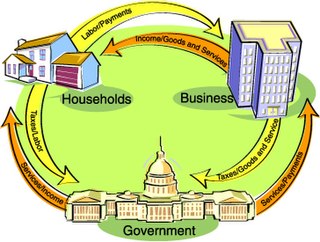Related Research Articles

Labour economics seeks to understand the functioning and dynamics of the markets for wage labour. Labour is a commodity that is supplied by labourers in exchange for a wage paid by demanding firms.

Microeconomics is a branch of economics that studies the behavior of individuals and firms in making decisions regarding the allocation of scarce resources and the interactions among these individuals and firms.

In microeconomics, supply and demand is an economic model of price determination in a market. It postulates that, holding all else equal, in a competitive market, the unit price for a particular good, or other traded item such as labor or liquid financial assets, will vary until it settles at a point where the quantity demanded will equal the quantity supplied, resulting in an economic equilibrium for price and quantity transacted.
This aims to be a complete article list of economics topics:
In economics, elasticity is the measurement of the percentage change of one economic variable in response to a change in another.
Price elasticity of demand, is the degree to which the effective desire for something changes as its price changes. In general, people desire things less as those things become more expensive. However, for some products, the customer's desire could drop sharply even with a little price increase, and for other products, it could stay almost the same even with a big price increase. Economists use the term elasticity to denote this sensitivity to price increases. More precisely, price elasticity gives the percentage change in quantity demanded when there is a one percent increase in price, holding everything else constant.

Health economics is a branch of economics concerned with issues related to efficiency, effectiveness, value and behavior in the production and consumption of health and healthcare. Health economics is important in determining how to improve health outcomes and lifestyle patterns through interactions between individuals, healthcare providers and clinical settings. In broad terms, health economists study the functioning of healthcare systems and health-affecting behaviors such as smoking, diabetes, and obesity.

Personal finance is the financial management which an individual or a family unit performs to budget, save, and spend monetary resources over time, taking into account various financial risks and future life events.

Endogenous growth theory holds that economic growth is primarily the result of endogenous and not external forces. Endogenous growth theory holds that investment in human capital, innovation, and knowledge are significant contributors to economic growth. The theory also focuses on positive externalities and spillover effects of a knowledge-based economy which will lead to economic development. The endogenous growth theory primarily holds that the long run growth rate of an economy depends on policy measures. For example, subsidies for research and development or education increase the growth rate in some endogenous growth models by increasing the incentive for innovation.
In microeconomics, an Engel curve describes how household expenditure on a particular good or service varies with household income. There are two varieties of Engel curves. Budget share Engel curves describe how the proportion of household income spent on a good varies with income. Alternatively, Engel curves can also describe how real expenditure varies with household income. They are named after the German statistician Ernst Engel (1821–1896), who was the first to investigate this relationship between goods expenditure and income systematically in 1857. The best-known single result from the article is Engel's law which states that the poorer a family is, the larger the budget share it spends on nourishment.

Real estate economics is the application of economic techniques to real estate markets. It tries to describe, explain, and predict patterns of prices, supply, and demand. The closely related field of housing economics is narrower in scope, concentrating on residential real estate markets, while the research on real estate trends focuses on the business and structural changes affecting the industry. Both draw on partial equilibrium analysis, urban economics, spatial economics, basic and extensive research, surveys, and finance.
The wealth elasticity of demand, in microeconomics and macroeconomics, is the proportional change in the consumption of a good relative to a change in consumers' wealth. Measuring and accounting for the variability in this elasticity is a continuing problem in behavioral finance and consumer theory.
Constant elasticity of substitution (CES), in economics, is a property of some production functions and utility functions. Several economists have featured in the topic and have contributed in the final finding of the constant. They include Tom McKenzie, John Hicks and Joan Robinson. The vital economic element of the measure is that it provided the producer a clear picture of how to move between different modes or types of production.
An out-of-pocket expense is the direct payment of money that may or may not be later reimbursed from a third-party source.
The following outline is provided as an overview of and topical guide to finance:
Amy Nadya Finkelstein is a professor of economics at the Massachusetts Institute of Technology (MIT), the co-director and research associate of the Public Economics Program at the National Bureau of Economic Research, and the co-Scientific Director of J-PAL North America. She was awarded the 2012 John Bates Clark Medal for her contributions to economics. She was elected to the National Academy of Sciences and won a MacArthur "Genius" fellowship in 2018.
Optimal capital income taxation is a subarea of optimal tax theory which studies the design of taxes on capital income such that a given economic criterion like utility is optimized.
Optimal labor income tax is a subarea of optimal tax theory which refers to the study of designing a tax on individual labor income such that a given economic criterion like social welfare is optimized.
Yuting Zhang is a Professor of Health Economics at the University of Melbourne, and an expert on economic evaluations of health policy and healthcare reforms. She is a journal editor, award recipient, and has written numerous articles in influential journals in her field.
References
- 1 2 3 4 5 Jones, Andrew M. Rice, Nigel, and Contoyannis, Paul. The Dynamics of Health in Jones, Andrew M., ed. The Elgar companion to health economics. Edward Elgar Publishing, 2012. p15
- ↑ Grossman 1972
- ↑ Phelps, Charles E. "Demand for reimbursement insurance." In The role of health insurance in the health services sector, pp. 115-162. NBER, 1976.
- ↑ Cropper, Maureen L. "Health, investment in health, and occupational choice." Journal of Political Economy 85, no. 6 (1977): 1273-1294.
- ↑ Ehrlich, Isaac. On the interaction between education and health and the concept of human capital. Mimeo., Jan, 1978.
- ↑ Acton, Jan Paul. "Nonmonetary factors in the demand for medical services: some empirical evidence." Journal of Political Economy 83, no. 3 (1975): 595-614.
- 1 2 Grossman 1982
- ↑ Manning, Willard G., Joseph P. Newhouse, Naihua Duan, Emmett B. Keeler, and Arleen Leibowitz. "Health insurance and the demand for medical care: evidence from a randomized experiment." The American economic review (1987): 251-277.
- ↑ Finkelstein, Amy, Sarah Taubman, Bill Wright, Mira Bernstein, Jonathan Gruber, Joseph P. Newhouse, Heidi Allen, Katherine Baicker, and Oregon Health Study Group. "The Oregon health insurance experiment: evidence from the first year." The Quarterly journal of economics 127, no. 3 (2012): 1057-1106.
- ↑ Muurinen, Jaana-Marja. "Demand for health: a generalised Grossman model." Journal of Health economics 1, no. 1 (1982): 5-28.
- ↑ Cropper, M. L. (1977). Health, investment in health, and occupational choice. Journal of Political Economy, 85(6), 1273-1294.
- ↑ ibid
- ↑ ibid
- ↑ Fuchs, V. R. (2004). Reflections on the socioeconomic correlates of health. Journal of health economics, 23(4), 653-661.
- ↑ ibid
- ↑ ibid